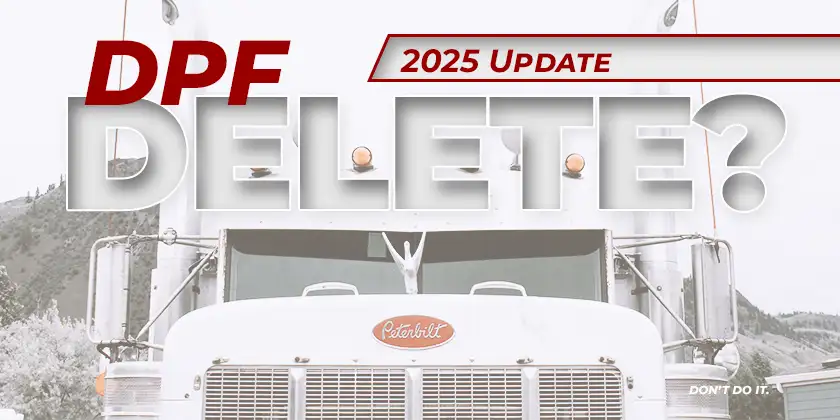
DPF Delete: The Myths, Realities, and Ramifications (2025 Update)
Diesel engines have long been a cornerstone of the commercial trucking industry, renowned for their durability and efficiency. However, as environmental concerns have grown, so have the regulations surrounding diesel emissions. Central to these regulations is the Diesel Emission System, and at its heart, the Diesel Particulate Filter (DPF). Understanding the DPF, its purpose, and the controversies surrounding ‘DPF deletes’ is crucial for Fleet Maintenance Managers, Technicians, and Truck Owners alike.
Emissions Tampering: A Reality Check (2025 Update)
A lot has happened since this article was originally published. While there have been plenty of changes as politics and regulations have shifted back and forth, one thing remains the same: deleting a truck’s emissions is risky business. Check out the DPF Delete FAQ as well.
I. The Truth About Emissions Tampering: It’s Still Illegal
Have you heard rumors that emissions tampering, or “deleting,” might be less chancy now? Think again. Despite what you might hear about shifting federal priorities or agency cuts, the truth is, it’s still 100% illegal and comes with serious consequences.
Bruce Balfour, vice president of Clean Diesel Specialists (CDS), puts it plainly:
“I don’t believe the EPA is going to back off of the federal regulations that are already on the books. As of now, it’s still 100% illegal to modify an emissions system”.
The EPA’s stance is clear: don’t tamper with or install kits to defeat emissions systems.
“I don’t see the Trump administration doing anything to reverse the emissions regulations that already exist,”
said Steve Hoke, president of Diesel Emissions Service (DES).
“To make a model change, a truck or engine manufacturer spends millions of dollars over a five- to eight-year planning period. So, any loosening of emissions regulations won’t be retroactive, in my opinion.”
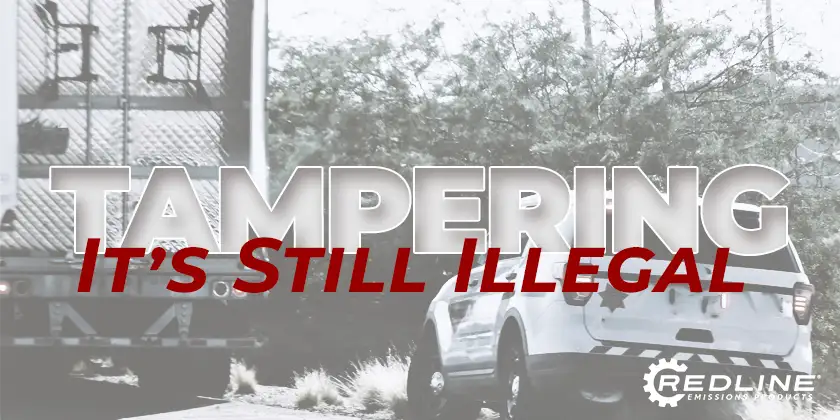
II. Stiff Penalties and Widespread Enforcement
Let’s be clear: the law is firm. The Clean Air Act defines tampering as “remov[ing] or render[ing] inoperative any device or element of design installed on or in engines/equipment in compliance with the regulations”.1 And the fines? They’re hefty. The EPA can hit you with a $45,268 penalty for each engine or part in violation. Knowingly selling or installing defeat devices? That’s another $4,500 per instance, plus daily fines for record-keeping violations.
And don’t think it’s just a “blue state” issue. We’ve seen major cases across the U.S., like a Nebraska shop facing over $670,000 in 2024, or a Texas trucking company settling for nearly $14,000 in 2021. Even under the Trump administration, enforcement was robust, proving that these actions transcend political shifts. The EPA has also heavily penalized diesel tuner manufacturers, with some fines climbing into the millions of dollars.
III. Dispelling the Myths: Deleting Offers No Real Benefit
Why do people still consider deleting? Years ago, it was about horsepower and fuel economy.
“But those pain points went away, for the most part,”
says Jason Hedman of Noregon.
Modern trucks, thanks to the 2014 GHG standard, actually improved fuel economy and horsepower while staying compliant. So, the performance argument is gone.
Today, it’s often “aggravation” or “fear” of expensive failures. But here’s the kicker:
“Emissions equipment has become wildly more reliable,”
Notes Paul Wilson of Calibrated Power Solutions.
Legitimate shops like Bullet Proof Diesel won’t even work on deleted trucks, and the necessary tuning is largely “shut down now”.
Another factor to consider is that aftertreatment systems are already baked into the engineering formula for diesel truck operation and efficiency. Tampering with these precision-engineered systems inevitably throws off their balance, leading to significant mechanical issues and pollutants down the road.
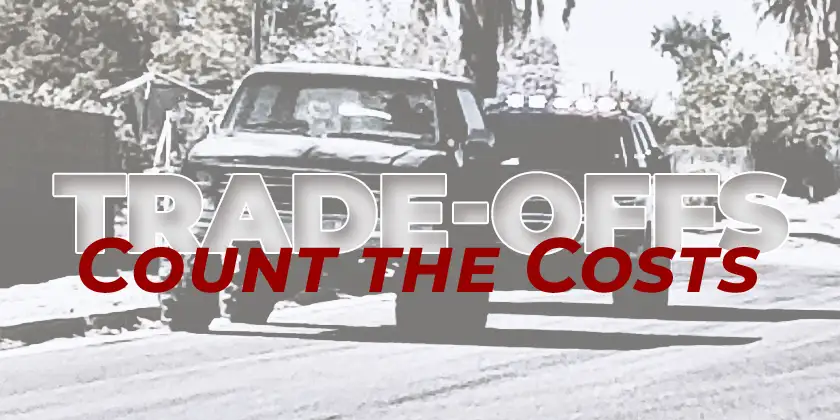
IV. High Likelihood of Detection and True Costs
Think you won’t get caught? The odds are “far too great for fleets to take a chance,” according to experts. Inspectors have multiple ways to spot tampering: plugging into diagnostic ports, “snap tests” on a dynamometer that make trucks “puff some smoke,” visual inspections for missing DPFs, and even roadside opacity meters or borescopes down the tailpipe. It’s a comprehensive net.
Hoke continued.
“…it’s interesting, I’ve heard of some truck owners spending $5,000 to have an EGR deleted when they could have just replaced it for $1,200. And the thing is, when you use a tune to cheat an emissions system, but still leave the physical components like the DPF intact, it’s still having to catch all that soot and ash. That’s still going to cause major problems down the road.”
Beyond the fines, consider the true cost: lost revenue from downtime, impounded vehicles, and the headache of finding unreliable, illicit repairs. Your warranty is gone, and good shops won’t touch your truck. It’s a dead end.
As Steve Hoke of Diesel Emissions Service sums it up like this:
“The industry is not going to turn into the Wild West like some truckers are thinking it will”.
Compliance isn’t just about avoiding fines; it’s about smart business, reliability, and long-term success. Don’t gamble your truck’s or fleet’s future based on fear.
Note: This update draws upon insights from “Deleters never prosper: Why emissions tampering is still high risk and low reward” by Gregg Wartgow, published in Fleet Maintenance.
The Diesel Emission System: A Brief Overview
In the early 1950s, a study in California highlighted the relationship between vehicles and air pollution, pinpointing car emissions as a primary factor for Los Angeles’s hazy skies. Originally, the average car released substantial amounts of hydrocarbons, nitrogen oxides, and carbon monoxide. However, with the intervention of the U.S. EPA, standards were established to reduce these emissions, prompting innovative solutions from the auto sector.
The EPA’s influence later expanded, overseeing emission control not only for cars but also for heavy-duty diesel vehicles. Achieving cleaner air involves multiple strategies, from enhanced engine/emissions technologies to improved fuel quality.
The Diesel Emissions System in its current form is comprised of several components like the Exhaust Gas Recirculation (EGR), Diesel Oxidation Catalyst (DOC), Selective Catalytic Reduction (SCR), and of course, the DPF. These mandated systems had a rocky start causing technical issues, frustrations, and in some cases lower performance. This led to DPF deletes becoming popular with some commercial and passenger truck owners.
Challenges with Diesel Emission Systems
As with any system, there are challenges. For truck owners, the Diesel Emission System has been a double-edged sword. While it plays a pivotal role in environmental protection, it’s also been linked to increased maintenance costs and downtime. Clogged DPFs can lead to reduced engine performance, necessitating cleaning or, in worst-case scenarios, replacement.
According to OverDriveOnline.com,
“Engine and emissions problems combined to account for the highest share of maintenance spending categories among used-truck buyers who responded to Overdrive’s 2021 Truck Purchase and Lease Survey. A combined 46% of used-truck buyers reported having to rebuild or conduct other engine work or having issues with emissions system components (23% each). Routine maintenance was the single-most common named maintenance issue, with 42% of used-truck buyers saying that has been their chief maintenance concern.”
This is what makes truck owners consider taking the risk and deleting these systems, but does deleting your DPF lower your total cost of operation to a level where the legal risks are worth it?
DPF Deletes: The Myths and Realities
Some have sought to bypass these challenges through ‘DPF deletes’, essentially removing or altering the DPF. While proponents claim enhanced performance and fuel efficiency, these benefits are often overstated. More importantly, they overshadow the environmental harm caused by bypassing a system designed to capture harmful pollutants and the financial and legal risks associated with deleting these systems.
According to Diesel Laptops, there are 5 common myths about DPF deletes. We’ve summarized these myths but if you want to read more in-depth information about emissions deletes make sure you read their entire article.
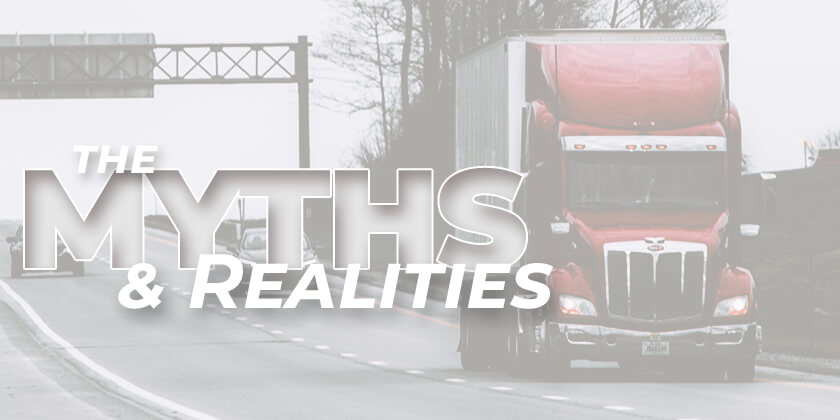
Myth #1 – DPF Deletes are Legal.
Here’s the straight truth: Making alterations to your truck’s emission system isn’t just frowned upon—it’s strictly illegal on a national level. While there is a legal pathway to remove your emission system, it comes with caveats: a rigorous re-certification process by the truck’s original maker. It’s neither simple nor cost-effective.
Myth #2 – There’s No Dedicated EPA Watchdog
Although there isn’t an official “EPA Watchdog” team patrolling every corner, that doesn’t mean regulations aren’t enforced. Just as the IRS operates without a ‘tax police’, local and state bodies have the power to uphold federal emission guidelines. Depending on where you reside, enforcement methods and intensity may vary, but the underlying rules are unwavering.
Myth #3 – The EPA Only Chases Big Players
Many believe that the EPA only has its sights set on industry mega carriers and national repair facilities. This couldn’t be further from the truth. From large equipment providers hit with hefty fines to individual truck enthusiasts tweaking a single vehicle, the EPA’s gaze is far-reaching. If you think you’re “flying under the radar,” think twice. A slip-up can cost a fortune in fines, no matter how ‘minor’ it may seem. Fines can range from $7,500 to $37,500 per day.
Myth #4 – Only California is Emission-Obsessed
While California might be infamously stringent about emissions, they’re not alone in the fight. At least 17 other states have committed to basically “do what California does” and specifically Texas has many counties that require emission testing on commercial trucks, and Minnesota and New York have established similar programs.
Myth #5 – Deleting DPFs Solves the Problem
Modern diesel engines are complex and deleting your emissions system can lead to major issues with the engine.
Legal Implications and Notable Penalties
Engaging in DPF deletes isn’t just environmentally questionable; it’s illegal. Authorities have issued significant penalties to those caught with deleted systems. These fines serve as a clear message: compliance is not optional. Beyond the immediate financial repercussions, companies caught engaging in such practices risk damage to their reputation, potentially affecting business relations and customer trust.
IN THE NEWS:
*** Idaho diesel shops fined $1 million in diesel deletion case. Read the full article on TPS. *** Sinister Diesel to pay $1M in fines – Roseville-based company made, sold ‘defeat devices’ for trucks. Read more.
A Better Way Forward: Education and Maintenance

Instead of seeking short-term solutions in DPF deletes, the better route is to understand the Diesel Emission System thoroughly. Knowledge is power. By understanding how these systems work, Fleet Maintenance Managers and Technicians can preemptively address issues, reducing downtime and associated costs.
Regular maintenance, using quality parts, and being proactive can alleviate many of the common challenges associated with the Diesel Emission System. Training and upskilling of staff, ensuring they’re familiar with the latest in emission technology, can also play a significant role.
DPF DELETE – FAQ
Q: What exactly is a “DPF delete?”
A: A DPF delete is the process of removing or disabling the Diesel Particulate Filter (DPF) from a diesel engine’s exhaust system. The DPF is a key component designed to capture and remove diesel particulate matter or soot from the exhaust gases of a diesel engine.
Q: Is it illegal to perform a DPF delete?
A: Yes, it is illegal. The Clean Air Act strictly prohibits tampering with any emission control device on a motor vehicle. Removing the DPF is a direct violation of this federal law.
Q: What are the penalties for a DPF delete?
A: The penalties can be quite severe. The Environmental Protection Agency (EPA) can impose fines of up to $45,268 per engine or part for tampering with emission systems. There are also significant fines for selling or installing devices that bypass or defeat emission controls.
Q: I’ve heard that a DPF delete can improve my truck’s performance. Is that true?
A: While that might have been a talking point in the past, modern diesel engines are designed to be highly efficient and powerful while still being compliant with emission standards. The claimed benefits of increased horsepower and fuel economy from a DPF delete are largely negated in newer trucks.
Q: So, why do people still get DPF deletes?
A: The main reason people consider it now is to avoid the potential for expensive repairs related to the DPF and other emissions equipment. However, this is a risky gamble, as the fines and other consequences far outweigh the potential savings. Additionally, modern emissions systems are more reliable than they were in the past.
Q: How would anyone even know if I’ve had a DPF delete?
A: It’s easier to detect than you might think. Inspectors have several ways to identify a tampered emissions system, including:
- Diagnostic port checks: They can scan your truck’s computer for signs of tampering.
- “Snap tests”: This involves running your truck on a dynamometer to measure emissions.
- Visual inspections: A trained inspector can often spot missing or modified components.
- Roadside opacity meters: These devices can measure the density of your truck’s exhaust smoke.
Q: Are there any other downsides to a DPF delete?
A: Absolutely. A DPF delete can void your truck’s warranty, and many reputable repair shops will refuse to work on a vehicle with a modified emissions system. This can lead to significant downtime and difficulty finding qualified mechanics.
Q: What’s the best way to avoid DPF problems in the first place?
A: The best approach is education and proper maintenance. Understanding how your diesel’s emission system works and keeping up with regular maintenance can prevent many of the issues that lead people to consider a DPF delete.
Work with the Experts
The Diesel Emission System, and the DPF in particular, might present challenges, but rather than seeking shortcuts that carry heavy financial and reputational risks, investing time and resources into understanding and maintaining these systems is the way forward.
If you’re tempted to consider a DPF delete, pause, and consult the experts. Ensure you’re making informed decisions that benefit not just your bottom line but the environment as well.
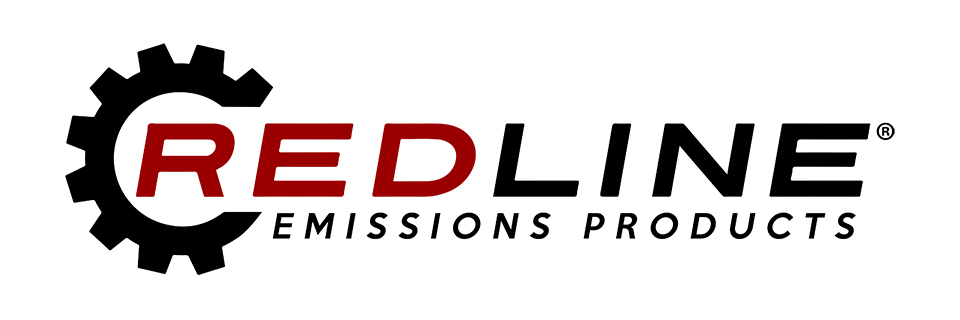
Call the Diesel Emissions experts first. Contact Redline Emissions Products today at 1-888-546-8741.
For inquiries or more information on our aftertreatment parts, DFP Cleaning equipment, or how to become an authorized REP distributor, feel free to contact us. We are here to assist you and provide the support you need every step of the way.
Want to find out more about becoming a Redline Emissions Products® dealer? Call 888-295-4670 and get in touch with our team. Anthony and Nadjara are happy to answer your questions.
Need Tech Support or need help troubleshooting a DPF problem? Contact REP Support at 1-888-564-4209







